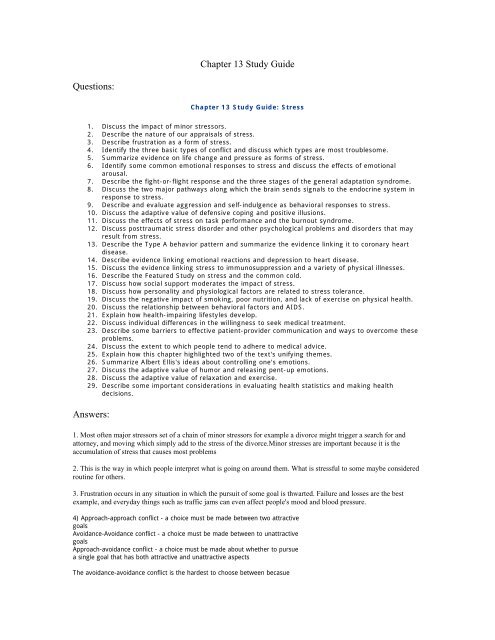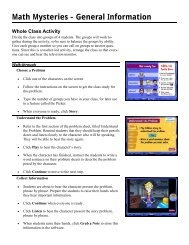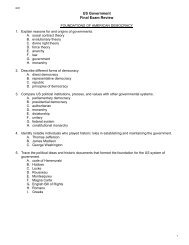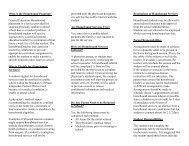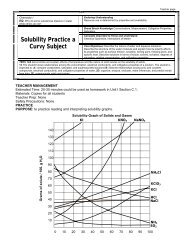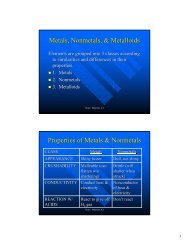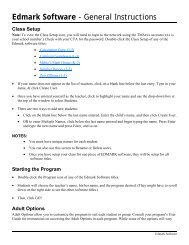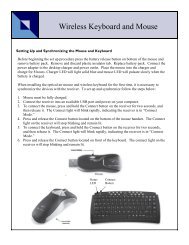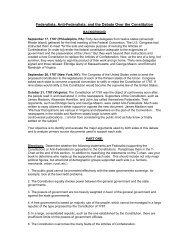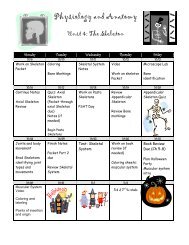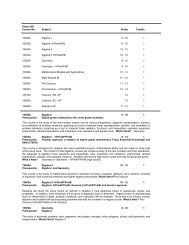Chapter 13 Study Guide Questions: Answers:
Chapter 13 Study Guide Questions: Answers:
Chapter 13 Study Guide Questions: Answers:
Create successful ePaper yourself
Turn your PDF publications into a flip-book with our unique Google optimized e-Paper software.
<strong>Chapter</strong> <strong>13</strong> <strong>Study</strong> <strong>Guide</strong><br />
<strong>Questions</strong>:<br />
<strong>Chapter</strong> <strong>13</strong> <strong>Study</strong> <strong>Guide</strong>: Stress<br />
1. Discuss the impact of minor stressors.<br />
2. Describe the nature of our appraisals of stress.<br />
3. Describe frustration as a form of stress.<br />
4. Identify the three basic types of conflict and discuss which types are most troublesome.<br />
5. Summarize evidence on life change and pressure as forms of stress.<br />
6. Identify some common emotional responses to stress and discuss the effects of emotional<br />
arousal.<br />
7. Describe the fight-or-flight response and the three stages of the general adaptation syndrome.<br />
8. Discuss the two major pathways along which the brain sends signals to the endocrine system in<br />
response to stress.<br />
9. Describe and evaluate aggression and self-indulgence as behavioral responses to stress.<br />
10. Discuss the adaptive value of defensive coping and positive illusions.<br />
11. Discuss the effects of stress on task performance and the burnout syndrome.<br />
12. Discuss posttraumatic stress disorder and other psychological problems and disorders that may<br />
result from stress.<br />
<strong>13</strong>. Describe the Type A behavior pattern and summarize the evidence linking it to coronary heart<br />
disease.<br />
14. Describe evidence linking emotional reactions and depression to heart disease.<br />
15. Discuss the evidence linking stress to immunosuppression and a variety of physical illnesses.<br />
16. Describe the Featured <strong>Study</strong> on stress and the common cold.<br />
17. Discuss how social support moderates the impact of stress.<br />
18. Discuss how personality and physiological factors are related to stress tolerance.<br />
19. Discuss the negative impact of smoking, poor nutrition, and lack of exercise on physical health.<br />
20. Discuss the relationship between behavioral factors and AIDS.<br />
21. Explain how health-impairing lifestyles develop.<br />
22. Discuss individual differences in the willingness to seek medical treatment.<br />
23. Describe some barriers to effective patient-provider communication and ways to overcome these<br />
problems.<br />
24. Discuss the extent to which people tend to adhere to medical advice.<br />
25. Explain how this chapter highlighted two of the text's unifying themes.<br />
26. Summarize Albert Ellis's ideas about controlling one's emotions.<br />
27. Discuss the adaptive value of humor and releasing pent-up emotions.<br />
28. Discuss the adaptive value of relaxation and exercise.<br />
29. Describe some important considerations in evaluating health statistics and making health<br />
decisions.<br />
<strong>Answers</strong>:<br />
1. Most often major stressors set of a chain of minor stressors for example a divorce might trigger a search for and<br />
attorney, and moving which simply add to the stress of the divorce.Minor stresses are important because it is the<br />
accumulation of stress that causes most problems<br />
2. This is the way in which people interpret what is going on around them. What is stressful to some maybe considered<br />
routine for others.<br />
3. Frustration occurs in any situation in which the pursuit of some goal is thwarted. Failure and losses are the best<br />
example, and everyday things such as traffic jams can even affect people's mood and blood pressure.<br />
4) Approach-approach conflict - a choice must be made between two attractive<br />
goals<br />
Avoidance-Avoidance conflict - a choice must be made between to unattractive<br />
goals<br />
Approach-avoidance conflict - a choice must be made about whether to pursue<br />
a single goal that has both attractive and unattractive aspects<br />
The avoidance-avoidance conflict is the hardest to choose between becasue
oth options are bad for you.<br />
5) Life changes are life changes, they require a person to adapt to<br />
something they're not used to. Holmes and Rahe found that many tuberculosis<br />
patients got the disease after many happy changes in their lives. Even<br />
though they were happy, they were still changes, and the changes created<br />
stress that made them more vulnerable to disease.<br />
Pressure is the way expectations demands one to behave. Holmes and Rahe<br />
also found that pressure can cause even more psychological symptoms than<br />
change. Many people choke under pressure and can't perform.<br />
6. When stress increases, the mood becomes negative. There are strong links<br />
between specific cognitive reactions to stress (appraisal) and specific<br />
emotions<br />
(a) Annoyance, anger and rage<br />
(b) Apprehension, anxiety and fear<br />
(c) Dejection, sadness and grief<br />
Lazarus says that the five others are guilt, shame, envy, jealousy and<br />
disgust.<br />
7. The fight - or -flight response is a physiological reaction to threat in which the autonomic nervous system mobilizes<br />
the organism for attacking (fight) or fleeing (flight) an enemy<br />
Alarm Reaction - organism recognizes the existence of a threat.<br />
Stage of Resistance - physiological change stabilizes as copying get under way<br />
Stage of Exhuastion - resistance declines, exhuasted, depleted<br />
8. Discuss the two major pathways along which the brain sends signals to the endocrine system in response to stress.<br />
*The hypothalamus is the brain structure that appears to initiate action along the two pathways<br />
(1)- The first pathway is through the autonomic nervous system. As a response to stress, the hypothalamus activates the<br />
sympathetic division of the ANS. Large amounts of catecholamines are released into the bloodstream when the central<br />
part of the adrenal gland is stimulated. When these hormones go through the body, the fight-or-flight response occurs.<br />
Heart rate and blood flow increase, and more blood is pumped into the brain and muscles. Respiration and oxygen<br />
consumption speed up, which facilitates alertness. The pupils also dilate to increase visual sensitivity.<br />
(2)- The second pathway is a more direct communication between the brain and the endocrine system. When the<br />
hypothalamus sends signals to the pituitary gland, it secretes a hormone (ACTH) that stimulates the outer part of the<br />
adrenal glands to release another important set of hormones the corticosteroids which stimulate the release of fats and<br />
proteins to increase energy. They also mobilize chemicals that help inhibit tissue inflammation in case of injury.<br />
9. Describe and evaluate aggression and self-indulgence as behavioral responses to stress.<br />
*Coping refers to active efforts to master, reduce, or tolerate the demands created by stress.<br />
*Aggression is any behavior that is intended to hurt someone, either physically or verbally. The frustration-aggression<br />
hypothesis holds that aggression is always caused by frustration. Freud, however, theorized that behaving aggressively<br />
could get pent-up emotion out of one’s system. He used the term catharsis to refer to the release of this emotional<br />
tension.<br />
*Stress may lead to self-indulgence which causes many people to engage in excessive consummatory behavior—unwise<br />
patterns of eating, drinking, smoking, using drugs, spending money, internet addiction, etc. when things are going poorly<br />
in one area of people’s lives, they may try to compensate by pursuing substitute forms of satisfaction.<br />
10. Defensive Coping: Defense Mechanisms:largely unconscious reactions that protect a person from unpleasant emotions<br />
such as anxiety and guilt. Help to shield individual from emotional discomfort elicited by stress.<br />
Positive Illusions: normal people tend to have overly favorable self-images. May be adaptive for mental health and well<br />
being.<br />
11. Baumeister's research shows that pressure can interfere with performance. While stress is not always bad and can<br />
motivate us, it can sometimes cause unneeded impairment, Research with Baseball finals shows that the home team is<br />
under much more stress than the opponent, hoping to win at home. Studies with " normal" people shows that choking<br />
under pressure is not uncommon.
Burnout: involves physical, mental, and emotional exhaustion that is attributable to long-term involvement in emotionally<br />
demanding situations. Physical: chronic fatigue, weakness and low energy. Mental: highly negative attitude towards<br />
oneself, ones work, and life. Emotional: feeling hopeless, helpless, and trapped.<br />
12. Discuss posttraumatic stress disorder and other psychological problems and disorders that may result from stress.<br />
The posttraumatic stress disorder (PTSD) involves enduring psychological disturbance attributed to the experience of a major<br />
traumatic event. Though posttraumatic stress disorders are widely associated with the experiences of Vietnam veterans, they are<br />
also seen as a result of other disturbing cases, including rape, robbery, assault, serious automobile accidents, witnessed death,<br />
and major natural disasters. Common symptoms of PTSD include reexperiencing the traumatic event in the form of nightmares<br />
and flashbacks, emotional numbing, alienation, problems in social relations, and elevated arousal, anxiety, and guilt. Chronic<br />
stress may also contribute to poor academic performance, insomnia, nightmares, sexual difficulties, alcohol abuse, drug abuse,<br />
and unhappiness. Stress has also been linked to the development of various psychological disorders, including depression,<br />
schizophrenia, anxiety disorders, and eating disorders.<br />
<strong>13</strong>. Describe the Type A behavior pattern and summarize the evidence linking it to coronary heart disease.<br />
The Type A personality includes three elements: (1) a strong competitive orientation, (2) impatience and time urgency, and (3)<br />
anger and hostility. Type A's are ambitious, hard-driving perfectionists who are exceedingly time-conscious. They routinely try to<br />
do several things at once, and they typically live a fast-paced, competitive, and achievement-oriented life. Research has shown<br />
that there is an apparent relationship between cynical hostility (characteristic of a Type A personality) and coronary disease,<br />
hypertension, and early mortality. Due to their overactive physiological reactivity, their ability to create stress in their lives, their<br />
antagonistic ways of relating to others, and their cynical tendency to push themselves to work hard (perhaps too hard), Type A<br />
personalities are particularly subject to developing serious heart conditions and shortened longevity.<br />
14. Emotional Reactions and Depression<br />
Lab experiments with cardiology patients have shown<br />
that brief periods of mental stress can trigger acute<br />
symptoms of heart disease, such as myocardial ischemia<br />
(inadequate blood flow to the heart) and chest pain.<br />
Studies have shown that the likelihood of myocardial<br />
ischemia increases two- or three-fold when people<br />
experience negative emotions. Also, they found that<br />
stress management training can reduce the likelihood<br />
of a second heart attack in cardiology patients.<br />
In a recent study examining a large group of people<br />
over <strong>13</strong> years found that people who were depressed in<br />
the beginning of the experiment were more likely than<br />
others to experience a heart attack during the next <strong>13</strong><br />
years. Since their depressive disorders preceded<br />
their heart attacks, this correlation cannot be<br />
attributed to the heart attacks causing the<br />
depression.<br />
15. The immune response is the body's defensive<br />
reaction to invasion by bacteria, viral agents, or<br />
other substances and depends heavily on actions<br />
initiated by specialized white blood cells called<br />
lymphocytes. Studies have shown that induced stress<br />
can impare immune functioning in animals. Stressors<br />
such as crowding, shock and restraint reduce various<br />
aspects of lymphocity reactivity in lab animals. This<br />
evidence has also been shown in humans, such as<br />
stressed out students during finals week. This<br />
immunosuppression leaves the body vulnerable to a<br />
variety of diseases such as rheumatoid arthritis,<br />
vaginal infections, genital herpes, periodontal<br />
disease, and inflammatory bowel disease.<br />
16.) 154 men and 266 women ranging from age 18-54 were given naasl drops that contained either a respiratory virus or<br />
a harmless saline solution. This double-blind procedure resulted that psychological stress is associated with increased<br />
susceptibility to biologically verified infectious disease processses.
17.) Social support refers to various types of aid and succor provided by members of one's social networks. Many studies<br />
have found evidence that social support is favorably related to physical health. Social support also seems to be good<br />
medicine for the mind as well as the body.<br />
18.) Optimistic people are more likely to engage in action-oriented, problem-focused coping. They are more willing than<br />
pessimists to seek social support, and therefore are more able to react positively to stress and have a higher stress<br />
tolerance.<br />
19. If you have poor nutrition it will cause a negative impact with stress<br />
tolerance. It high cholesterol level resulting in heart disease, high salt or<br />
caffeine intake leads to development of hyper tension, and high fat can lead to<br />
cancer. Lack of exercise causes a problem as well. Exercise helps you live<br />
longer, strengthen the cardiovascular cycle, reduce risk of obesity or diabetes,<br />
and decrees risks of cancers. Also, Smoking is a problem due to its nicotine<br />
and tar buildup. It has a high percentage to leading to cancer and death.<br />
20. Aids is derived from the virus HIV and there are many behaviors<br />
associated with the transmission of it. In the United states 80% of AIDS<br />
transmissions have occured either among gay men or intavenous drug users,<br />
yeilding a common misconception in the united states. Heterosexual contact<br />
is to blame for the most transmissions of HIV worldwide and it has been<br />
discovered taht stress might have somethign to do with the progression of<br />
AIDS.<br />
21 Health-impairing lifestyles develop because of the fact that they creep up on people slowly, and they normally include<br />
activities that are quite pleasant. Risks that are associated with it are normally 10 to 20 to 30 years down the road.<br />
22 Some people see the same unpleasant situations as symptoms while others just see them as a nuisance. So those<br />
that see them as symptoms like people that are high in anxiety and neurotic ism rush off to a physician more often.<br />
23. There are several things you can do to overcome the patient-provider<br />
communication barrier. One thing you can do is arriving on time with your<br />
questions ready in advance. Don’t be embarrassed if you don’t understand<br />
some of the terms and ask the doctor to clarify. Voice your doubts about the<br />
suitability or feasibility of your doctors recommendations.<br />
# 24.<br />
Evidence shows that people do not adhere to medical advice 30-60% of the<br />
time. There are several reasons for this but three main factors are failure<br />
to understand instructions, difficult or routine breaking instructions, and<br />
a negative attitude towards your physician.<br />
25. Explain how this chapter highlighted two of the text’s unifying themes.<br />
(1.) Behavior and health are influenced by multiple causes.<br />
(2.) Experience is highly subjective, as stress lies in the eye of the beholder.<br />
26. Summarize Albert Ellis’s ideas about controlling one’s emotions.<br />
He believes that people can short-circuit their emotional reactions to stress by altering their appraisals of stressful<br />
events. The insights about stress appraisal are the foundation for a widely used system of therapy that he devised. He<br />
emphasizes the importance of reappraising stressful situations to detect and dispute catastrophic thinking. According to<br />
Ellis, emotional distress is often due to irrational assumptions that underlie one’s thinking. Refer to page 561 for chart of<br />
Ellis’s view.<br />
27. Discuss the adaptive value of humor and releasing pent-up emotions.<br />
Humor may be useful in efforts to redefine stressful situations. In some cases, it may pay to release pent-up<br />
emotions. Talking it out may help drain off negative emotions.<br />
28. Discuss the adaptive value of relaxation and exercise.
Relaxation techniques, such as Benson’s relaxation response (chart on pg. 562), can reduce the wear and tear of<br />
stress. Getting adequate sleep, consuming a nutritionally sound diet, and controlling overeating and drug use may also<br />
reduce physical vulnerability.<br />
29. Describe some important considerations in evaluating health statistics and making health decisions.<br />
Evaluating Statistics on Health Risks:<br />
(1.) Correlation is no assurance of causation<br />
(2.) Statistical significance is not equivalent to practical significance<br />
(3.) Base rates should be considered in evaluating probabilities<br />
Thinking Systematically about Health Decisions<br />
(1.) Seek info to reduce uncertainty<br />
(2.) Make risk-benefit assessments<br />
(3.) List alternative courses of actions<br />
It is important to keep in mind that not all statistics on health risks<br />
are exact since everything people do, touch, or consume can cause illness.<br />
Studies are done to a large amount of people also which loves validity and<br />
reliability. It is important to gather information when making heath decisions in<br />
order to qualify the degree of uncertainty. Also, list all the possible outcomes<br />
and course of action so no risks will stand in the way of decision making.


